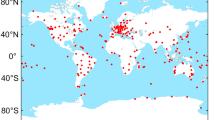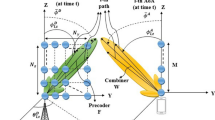Abstract
An algorithm based on sparse representation for joint angle and Doppler frequency estimation in multiple-input multiple-output radar is proposed. Through the data reconstruction, the algorithm only requires the dictionary for one-dimensional angle [e.g. direction of departure (DOD)], which reduces the computational complexity compared to conventional method using dictionary for two-dimensional angle. The DOD can be estimated by finding the non-zero rows in the recovered matrix, which also contains the information of the direction of arrival (DOA) and the Doppler frequency, and they can be achieved via singular value decomposition and least squares (LS) principle. The estimated DOD, DOA and Doppler frequency can be automatically paired and the parameter estimation performance of the proposed algorithm is better than that of estimation of signal parameters via rotational invariance techniques (ESPRIT)-based algorithm and parallel factor (PARAFAC) method. Furthermore, the proposed algorithm requires no knowledge of the number of targets and works well for coherent targets. Simulation results verify the effectiveness of the algorithm.









Similar content being viewed by others
References
Bencheikh, M. L., & Wang, Y. (2010). Joint DOD-DOA estimation using combined ESPRIT-MUSIC approach in MIMO radar. Electronics Letters, 46(15), 1081–1083.
Bencheikh, M. L., Wang, Y. D., & He, H. Y. (2010). Polynomial root finding technique for joint DOA DOD estimation in bistatic MIMO radar. Signal Processing, 90(9), 2723–2730.
Berg, E. V. & Friedlander, M. P. (2007). SPGL1: A solver for large-scale sparse reconstruction, June. http://www.cs.ubc.ca/labs/scl/spgl1.
Candes, E., Romberg, J., & Tao, J. (2006). Robust uncertainty principles: Exact signal reconstruction from highly incomplete frequency information. IEEE Transactions on Information Theory, 52(2), 489–509.
Davenport, M. A., Boufounos, P. T., Wakin, M. B., et al. (2010). Signal processing with compressive measurements. IEEE Journal of Selected Topics on Signal Processing, 4(2), 445–460.
Donoho, D. L. (2006). Compressed sensing. IEEE Transactions on Information Theory, 52(4), 1289–1306.
Duofang, C., Baixiao, C., & Guodong, Q. (2008). Angle estimation using ESPRIT in MIMO radar. Electronics Letters, 44(12), 770–771.
Fishler, E., Haimovich, A., Blum, R. S., Cimini, L. J., Chizhik, D., & Valenzuela, R. A. (2004). MIMO radar: An idea whose time has come. In Proceedings of the IEEE Radar Conference (pp. 71–78).
Guo, X., Wan, Q., Chang, C., & Lam, E. Y. (2010). Source localization using a sparse representation framework to achieve super resolution. Multidimensional System and Signal Processing, 21(4), 391–402.
Hu, N., Ye, Z., Xu, D., & Cao, S. (2012). A sparse recovery algorithm for DOA estimation using weighted subspace fitting. Signal Processing, 92, 2566–2570.
Jinli, C., Hong, G., & Weimin, S. (2008). Angle estimation using ESPRIT without pairing in MIMO radar. Electronics Letters, 44(24), 1422–1423.
Li, J. & Stoica, P. (2006). MIMO radar–diversity means superiority. In Proceedings of the 14th adaptive sensor array processing workshop (ASAP ’06) (pp. 1–6). Mass, USA: Lincoln Laboratory.
Li, J., Stoica, P., Xu, L., & Roberts, W. (2007). On parameter identifiability of MIMO radar. IEEE Signal Processing Letters, 14(12), 968–971.
Li, J., Liao, G., & Griffiths, H. (2011). Bistatic MIMO radar space-time adaptive processing. In 2011 IEEE International Radar Conference (pp. 498–502). Kansas City, Missouri: Westin Crown Center.
Liu, Z., Ruan, X., & He, J. (2013). Efficient 2-D DOA estimation for coherent sources with a sparse acousticvector-sensor array. Multidimensional Systems and Signal Processing, 24(1), 105–120.
Liu, Y., Wu, M., & Wu, S. (2010). Fast OMP algorithm for 2D angle estimation in MIMO radar. Electronics Letters, 46(6), 444–445.
Malioutov, D., Cetin, M., & Willsky, A. S. (2005). A sparse signal reconstruction perspective for source localization with sensor arrays. IEEE Transactions on Signal Processing, 53(8), 3010–3022.
Mallat, S. G., & Zhifeng, Z. (1993). Matching pursuits with time frequency dictionaries. IEEE Transactions on Signal Procesing, 41(12), 3397–3415.
Mishali, M., & Eldar, Y. C. (2010). From theory to practice: Sub-Nyquist sampling of sparse wideband analog signals. IEEE Journal of Selected Topics on Signal Processing, 4(2), 375–391.
Nion, D., & Sidiropoulos, N. D. (2009). Adaptive algorithms to track the PARAFAC decomposition of a third-order tensor. IEEE Transactions on Signal Processing, 57(6), 2299–2310.
Sharma, R. (2010). Analysis of MIMO radar ambiguity functions and implications on clear region. In IEEE Radar Conference (pp. 544–548).
Stoica, P., & Nehorai, A. (1990). Performance study of conditional and unconditional direction-of-arrival estimation. IEEE Transactions on Signal Processing, 38(10), 1783–1795.
Tropp, J. A., & Gilbert, A. C. (2007). Signal recovery from random measurements via orthogonal matching pursuit. IEEE Transactions on Information Theory, 53(12), 4655–4666.
Xu, L., Li, J., & Stoica, P. (2006). Adaptive techniques for MIMO radar. In Proceedings of the 4th workshop on sensor array and multichannel signal processing (pp. 258–262).
Xu, L., Li, J., & Stoica, P. (2008). Target detection and parameter estimation for MIMO radar systems. IEEE Transactions on Aerospace Electronics System, 44(3), 927–939.
Yan, H., Li, J., & Liao, G. (2008). Multitarget identification and localization using bistatic MIMO radar systems. EURASIP Journal on Advances in Signal Processing. Article ID283483, pp. 1–8.
Yang, M., & Zhang, G. (2012). Compressive sensing based parameter estimation for monostatic mimo noise radar. Progress in Electromagnetics Research Letters, 30, 133–143.
Yu, Y., Petropulu, A., & Poor, H. V. (2010). MIMO radar using compressive sampling. IEEE Journal of Selected Topic Signal Processing, 4(1), 146–163.
Yunhe, C. (2010). Joint estimation of angle and Doppler frequency for bistatic MIMO radar. Electronics Letters, 46(2), 170–172.
Zhang, X., Xu, L., & Xu, L. (2010). Direction of departure (DOD) and direction of arrival (DOA) estimation in MIMO radar with reduced-dimension MUSIC. IEEE Communications Letters, 14(12), 1161–1163.
Zhang, X., Xu, Z., Xu, L., & Xu, D. (2011). Trilinear decomposition-based transmit angle and receive angle estimation for multiple-input multiple-output radar. IET Radar, Sonar and Navigation, 5(6), 626–631.
Zheng, G., Chen, B., & Yang, M. (2012). Unitary ESPRIT algorithm for bistatic MIMO radar. Electronics Letters, 48(3), 179–181.
Zheng, Z. D., & Zhang, J. Y. (2011). Fast method for multi-target localization in bistatic MIMO radar. Electronics Letters, 47(2), 138–139.
Zhuang, S., & Zhu, X. (2013). Improved design of unimodular waveforms for MIMO radar. Multidimensional Systems and Signal Processing, 24, 447–456.
Acknowledgments
This work is supported by China NSF Grants (61201208, 61271327, 61071164), Jiangsu Planned Projects for Postdoctoral Research Funds (1201039C), China Postdoctoral Science Foundation (2012M521099), Open project of key laboratory of underwater acoustic communication and marine information technology (Xiamen University), Hubei Key Laboratory of Intelligent Wire1ess Communications (IWC2012002), Open project of Key Laboratory of Nondestructive Testing (Nanchang Hangkong University), Open project of Key Laboratory of modern acoustic of Ministry of Education (Nanjing University), the Aeronautical Science Foundation of China (20120152001), PAPD of Jiangsu Higher Education Institutions, Research Innovation Program for College Graduates of Jiangsu Province (CXZZ13_0165), Funding for Outstanding Doctoral Dissertation in NUAA (BCXJ13-09), Qing Lan Project and the Fundamental Research Funds for the Central Universities (NS2013024, NZ2012010, kfjj120115, kfjj20110215).
Author information
Authors and Affiliations
Corresponding author
Rights and permissions
About this article
Cite this article
Li, J., Zhang, X. Sparse representation-based joint angle and Doppler frequency estimation for MIMO radar. Multidim Syst Sign Process 26, 179–192 (2015). https://doi.org/10.1007/s11045-013-0248-1
Received:
Revised:
Accepted:
Published:
Issue Date:
DOI: https://doi.org/10.1007/s11045-013-0248-1




